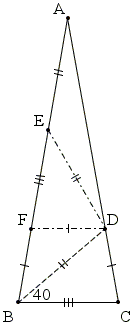The 80-80-20 Triangle Problem,
A Curious Partition, Solution

The 80-80-20 triangle can be partitioned in a curious way: let BD, with D on AC, bisect angle B. Then
|Contact| |Front page| |Contents| |Geometry| |Up|
Copyright © 1996-2018 Alexander Bogomolny
The 80-80-20 triangle can be partitioned in a curious way: let BD, with D on AC, bisect angle B. Then

Let F on AB be such that DF||BC and choose E on AB so that
On the other hand, ∠BDC = 180° - 40° - 80° = 60°. Therefore,
ΔBFD is also isosceles because ∠BDF = 180° - 80° - 60° = 40°, such that
Finally, ∠EDF = 80° - 20° = 60° = ∠EDC. We see that triangles BCD and EFD are equal (by SAS), implying
It follows that
| AD | = AF | |
| = AE + EF | ||
| = BD + BC. |
As a follow up, an inverse problem has been posted at the old CTK Exchange:
In ΔABC, ∠B = 80°. The bisector of angle B meets AC in D such that
There is a solution.
|Contact| |Front page| |Contents| |Geometry| |Up|
Copyright © 1996-2018 Alexander Bogomolny
73607171
